Mexico City, 1946: the first novitiate community of the Legionaries of Christ.
History of Legionary Spirituality
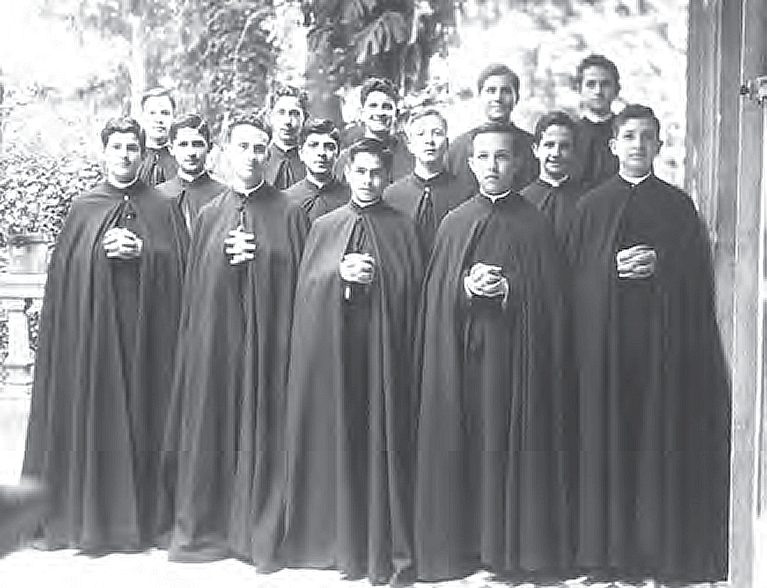
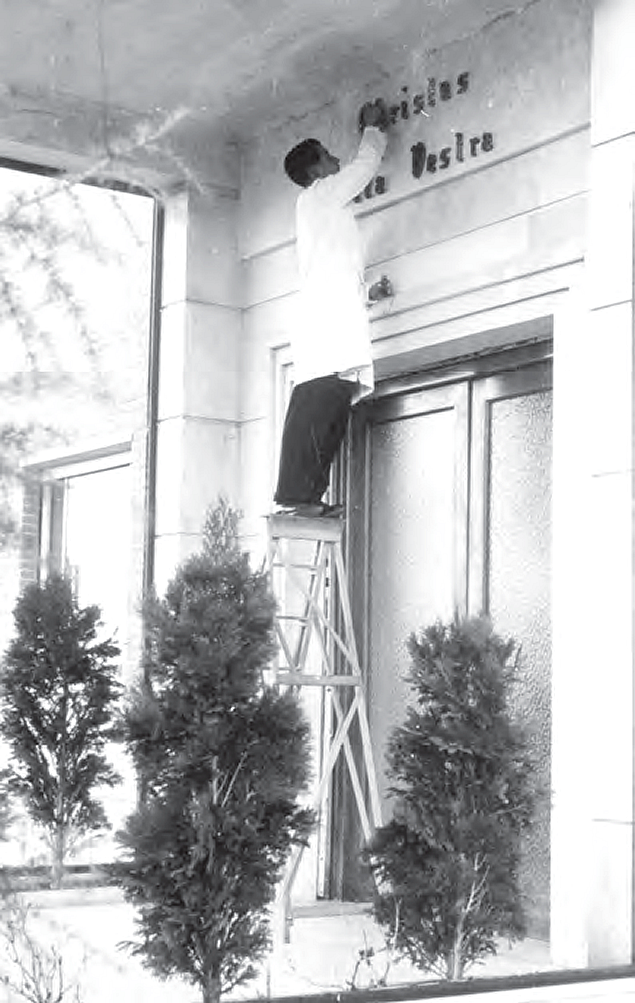
Spain, 1963: a novice cleaning the text “Christus vita vestra” from the porch of the novitiate in Salamanca.
Christocentrism
Christocentrism is the main characteristic of the Legionary spirituality. At first, it was presented primarily as the fundamental spiritual orientation in the formation of novices, applied from the very first steps in the Congregation. Even in the 1948 Constitutions, the term “Christocentric formation” is mentioned, requiring that “Jesus Christ be the criterion, the center, and the example of all the spiritual life” of the novices. Shortly after the creation of the novitiate in Salamanca, in the early months of 1959, the first generation of novices at that center placed an emblematic inscription on the entrance porch: Christus vita vestra.
The 1965 version of the Constitutions clarified this text from 1948: the Christocentric formation of the novices was meant to ensure that Christ would be the “criterion, the center, and the model of all religious, priestly, and apostolic life.” A very precise program. In 1969, the community at the Higher Studies Center in Rome, organized in study teams, published internally a work in nine volumes that explained the nature of a Legionary religious.
The work was titled Un legionario debe ser (A Legionary Must Be) and began with 24 precise definitions. The last of these points stated that a Legionary must be Alter Christus, another Christ. According to the authors, these principles should be a “synthesis of that wonderful breath of God by which our old clay is transformed into a new man: Jesus Christ. In Him, the Legion and the Legionary find their center, their explanation, their reason for being, their beginning and end, their ideal and path, their truth and their life.” Since then, a card with these principles was written and placed on the desks or workspaces of the Legionaries of Christ. Two years later, these same definitions were added to the Manual del Regnum Christi of 1971: in fact, the “apostle of the Regnum Christi,” that is, the “man of the Kingdom,” was also to “be another Christ.”
Charity
In the early pages of the 1941 diary, among the general notes on the Statutes and Schedules of the “Apostólica Misional del Sagrado Corazón de Jesús,” it is written that “the superiors will require that the relations between brothers be imbued with charity.” In the 1945 edition of the Regnabit magazine, it is stated:
“Since Christ Jesus is our model, and we, aided by His divine grace, strive to imitate Him, the virtue of charity toward our brothers must stand out among the others. It is daily instilled in us by our superiors, and we work to put it into practice, treating our companions with much delicacy, circumspection, and modesty, without distinguishing anyone, nor hurting their feelings with murmurs or contempt.”
Therefore, from the earliest documents, charity emerges as the main virtue to be practiced by the future religious of the Congregation, and it remained so thereafter.
The centrality of charity was also confirmed when, by the late 1960s, the lay members of the Regnum Christi joined in each of its branches. The first version of the Manual del Regnum Christi from 1969 places charity, considered as “a distinctive and apostolic force,” among the “fundamental lines of spirituality” that “should wave in front of any project of the Movement”; Regnum Christi “receives this mandate from Christ and this inheritance from the first Christians and makes it a program,” since “charity is the true force of apostolic impact, the true and synthetic Christian testimony that contains within it all the vigor and evangelizing and sanctifying power of Christianity.”
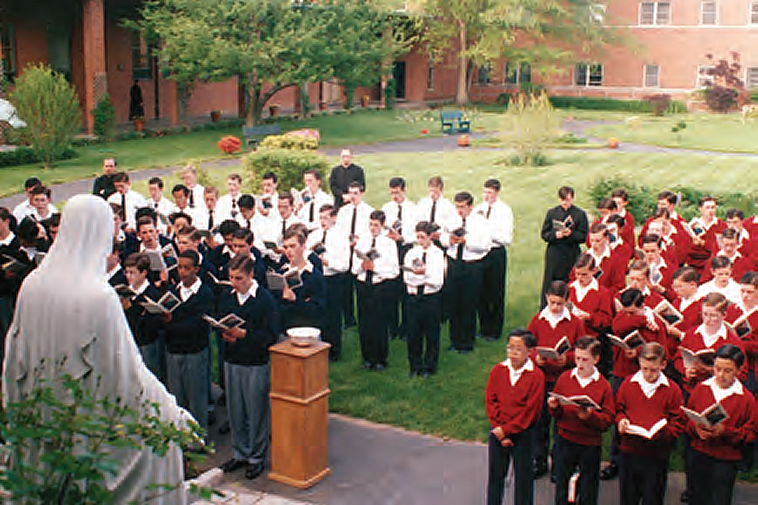
United States, May 31, 1997: A moment of consecration to the Virgin by the communities of apostolic members, pre-candidates, and candidates of the Apostólica dedicated to the Immaculate Conception.

Vatican, Paul VI Hall, 2004: A group photo of young collaborators of Regnum Christi with Saint John Paul II, who also signed in Latin.
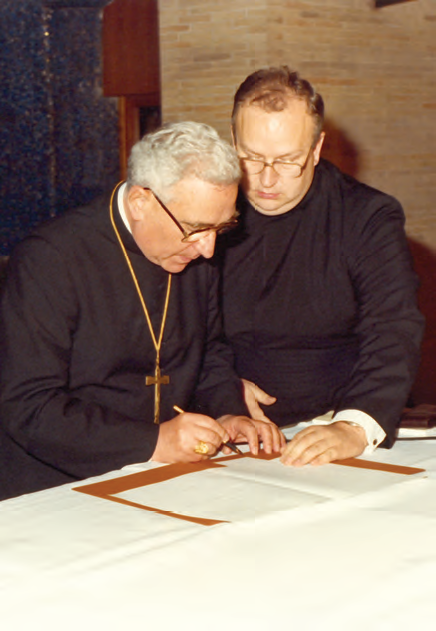
Other aspects of spirituality
In more recent years, Christocentrism and charity have been confirmed as specific characteristics of spirituality in all the institutional texts of the Congregation. These writings, in addition to these and the devotion to the Sacred Heart of Jesus, have also emphasized other aspects of spirituality, such as the ideal described as the “establishment of the Kingdom of Christ,” the “contemplative and evangelizing” spirit, love for the Holy Spirit, the Church, the Pope, Mary, and one’s own vocation, as well as the importance of fostering the “spirit of unity and the union of hearts.”
When presenting the Constitutions approved in 1983, Cardinal Eduardo Pironio urged the Legionaries present with the following words: “Love Christ, love Mary, love the Church, love the Legion.”
All of these essential lines also appear in the document Lineamentos del carisma del Movimiento Regnum Christi (Guidelines of the Charism of the Regnum Christi Movement) from October 2012: “In this framework, the spirituality of Regnum Christi proposes that its members particularly cultivate five supernatural loves: love for Jesus Christ, love for the Church and the Pope, love for the Blessed Virgin Mary, love for souls, and love for Regnum Christi.”
Devotions, Protectors, and Patrons
On January 3, 1941, a First Friday of the month, dedicated to the Sacred Heart of Jesus according to the devotional practice revealed to Saint Margaret Mary Alacoque, the diary of the “Apostólica Misional del Sagrado Corazón de Jesús” recounts how every first Friday of the month at that seminary, the Holy Mass was to be sung, a retreat was held, and the Blessed Sacrament was exposed. Additionally, every Friday, the Litany of the Sacred Heart was recited. The chronicle also mentions that on the feast of the Sacred Heart in 1941, the first celebration by what was then still a small community, a statue of the Sacred Heart was solemnly placed on the altar of the seminary chapel. All the apostolics then consecrated themselves to the Sacred Heart, which, in those early years before the formal recognition by the Holy See, held a particular meaning as it somewhat substituted their religious vows.
A passage from this chronology illustrates this aspect:
“The bond of union with which the individuals of religious communities are united are the temporary or perpetual religious vows. And so, this nascent Congregation should have a certain voluntary and free commitment of the soul to the Divine Heart of Jesus, through the personal consecration of oneself, as a means of intimate union of the heart of each person, for their own sanctification and perseverance in the religious life they intend to embrace.”
It is not a coincidence that in September 1947, the Mexican boys who had completed their novitiate, unable to take their vows as the canonical erection had not yet occurred, traveled to the town of Paray-le-Monial in France to consecrate themselves to the Sacred Heart of Jesus in the basilica that symbolized their devotion.
In the 1948 Constitutions, the Sacred Heart of Jesus is named as the celestial and primary patron, while the 1965 Constitutions clarified that the Congregation was dedicated to Him. This dedication remains in the 2014 Constitutions, which further specify how the Legionary should have:
“In the worship of the Sacred Heart, a privileged path to form a meek and humble priestly heart and propagate His Kingdom in the world. In the Heart of Christ, one finds the merciful love of God, which leads one to embrace the cross in their own life, make reparation for sins, and give oneself to others.”
All constitutional texts place alongside the devotion to the Sacred Heart, that of Our Lady of Sorrows, whose feast is on September 15. On this date, traditionally, hundreds of Legionaries of Christ have entered the novitiate and received the religious habit in a ceremony known as the “delivery of the uniform,” or they have made their first religious profession. The Congregation also has other patrons and protectors: since 1948, Saint John the Evangelist has been considered the “celestial patron,” while the “special protectors” are Saint Joseph, Saint Michael the Archangel, and Saint Paul the Apostle.
Particularly in the early years, the chapels of Legionary centers were adorned with statues of some of these saints, placed at the sides of the altar. To honor them, the Legionaries of Christ dignify the respective annual feasts, striving, as stated in the 1984 “Principles and Norms” manual, “to live with depth, with a spirit of faith, and with joy these feasts to find strength on their path toward God and to renew themselves spiritually.” Over time, these devotions have become spiritual patrimony for the Regnum Christi Movement.
The 1988 private Statutes established that members must practice “authentic devotion to the Sacred Heart of Jesus, which consists of true piety, personal, faithful, and passionate love for Him, the example, the way, and the life of the soul, and imitation through the practice of all His virtues.”
The same document designates as the protector of the first degree the Immaculate Virgin “for her authenticity in living the demands of her faith, for her submission to the will of God, for her piety, for her humility, for her charity toward others, for her gratitude, for her strength in suffering, for her freedom in regard to material goods in the purity and poverty of life, and for her joyful surrender to family duties.” As protector of the second degree, Saint Paul is mentioned for being “a profound knower of God’s salvific plan, personally in love with Christ, and an indefatigable apostle of His Kingdom.” Finally, the third-degree protectors are Saint Paul “as a model of love for Christ and tireless zeal for the expansion of the Kingdom,” and Saint John the Evangelist, “a disciple of virginal consecration to Christ, of love, of unity, and of fidelity.”
Recently, in the Statutes approved in 2013, the consecrated laity invoke Saint Paul as “a model of configuration with Christ and passionate apostle of evangelization,” while the consecrated women recognize the same devotions as the Legionaries.
It is important to recall how every year, members of the Movement gather in various locations to celebrate the Day of Regnum Christi on the Solemnity of Christ the King. This aspect of spirituality was emphasized by the papal delegate De Paolis, who in a homily given at the Shrine of Our Lady of Sorrows in Rho, Italy, on November 11, 2012, precisely on the Solemnity of Christ the King, said: “And in a particular way, I address you who belong to the Regnum Christi Movement: it is the Kingdom of God that you possess in your heart, it is the Kingdom of God that you want to guard and rediscover. It is this Kingdom that you want to be witnesses and apostles of.”
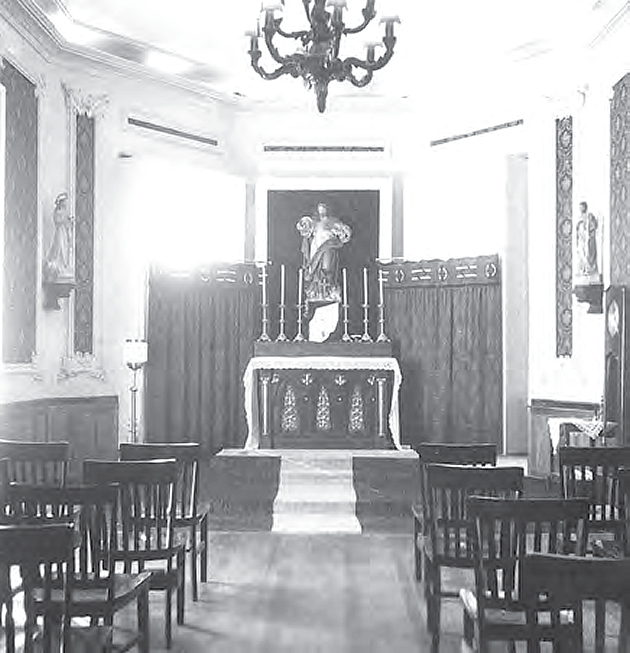
Mexico City, 1946: Chapel of the “Apostólica Misional del Sagrado Corazón de Jesús.” On the altar, the statue of the Sacred Heart of Jesus is visible, with the statue of Saint John the Evangelist on the left and the statue of Saint Joseph on the right.
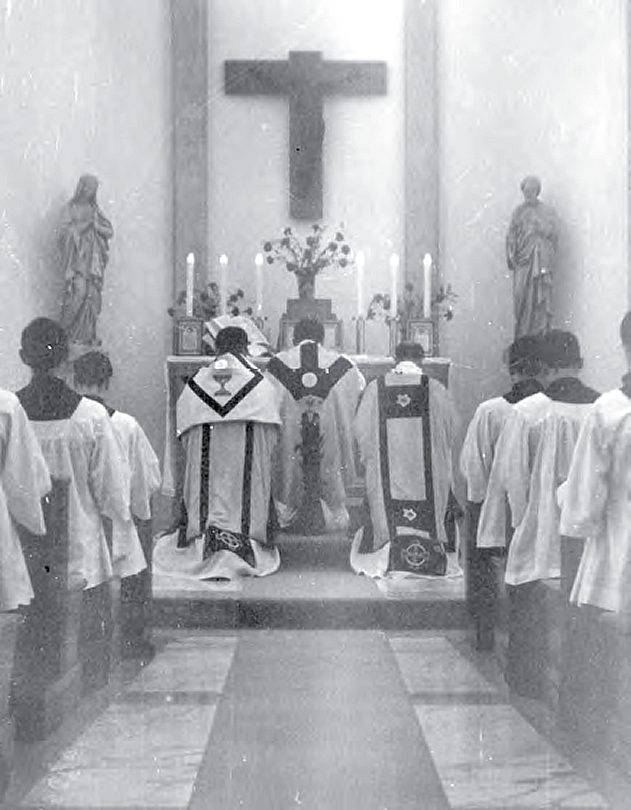
Rome, General Curia of the Legionaries of Christ, 1956: A moment during the Eucharistic celebration; the altar of the chapel is visible, with the statue of the Virgin on the left and that of Saint Joseph on the right.
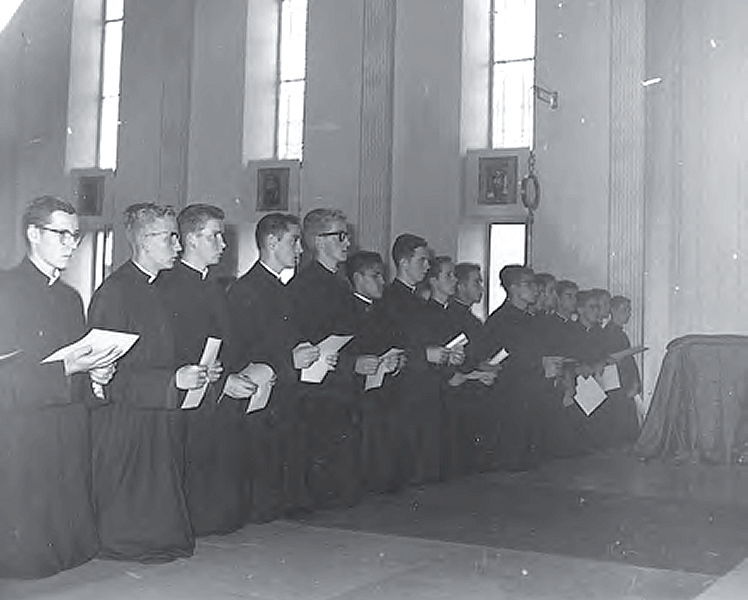
Spain, September 15, 1962: On the feast day of Our Lady of Sorrows, a large group of Legionaries from the Novitiate of Salamanca make their first religious profession in the chapel of the center.

Italy, Rho, November 11, 2012: Group photo of the Pontifical Delegate, Velasio De Paolis, CS, with the Pro-Director General, Father Sylvester Heereman, LC, and other Legionaries of Christ and members of Regnum Christi on the day of the Solemnity of Christ the King.
This section has been taken from the publication «Historia Institucional de la Congregación de los Legionarios de Cristo y del Movimiento Regnum Christi» (2015), prepared by the General Historical Archive of the Legion of Christ and Regnum Christi and published on the occasion of the 75th anniversary of the Congregation.
Published originally in Spanish and Italian.
Texts: Salvatore Luciano Bonventre | Translations: Fr. Gonzalo Franco, LC | Selection of photographs: Salvatore Luciano Bonventre and Luigi Baldassarri | Coordination: Fr. Jaime Rodríguez, LC and Fr. Rodrigo Ramírez, LC


